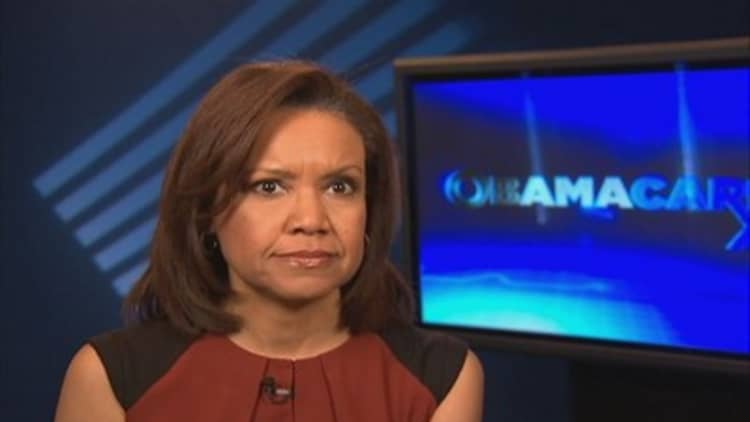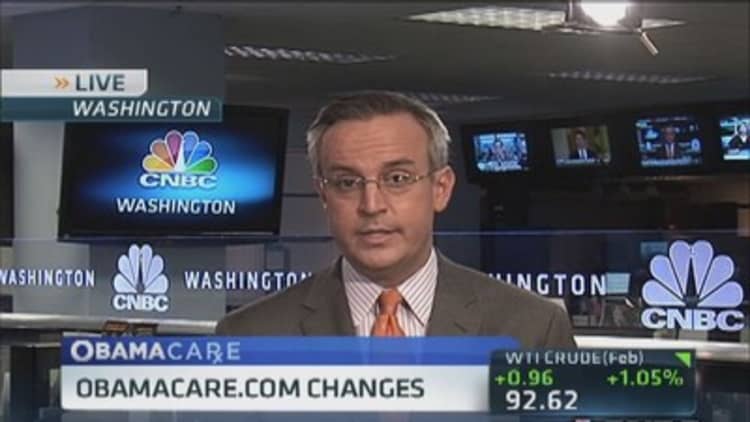
Obamacare's got some ways to go in signing up young adults.
Young adults make up just 24 percent of the 2.2 million people who have enrolled in private Obamacare insurance plans nationally so far, a rate that not only lags the 40 percent target originally set by federal officials, but also slightly trails their share of the total eligible population, new data released Monday shows.
And 55 percent of the enrollees are between the ages of 45 and 64, data shows.
However, officials on Monday said that the sign-up rate by young adults at the halfway point for Affordable Care Act enrollment is in line with that they expected by this point, and also confidently predicted the proportion of 18-to-34 year olds would rise by the March 31 close of enrollment.
"We're actually very pleased with the percentage we have so far, and we expect that percentage to increase," said Gary Cohen, deputy Administrator and director of the Center for Consumer Information and Insurance Oversight at the Centers for Medicare & Medicaid Services.
(Read more: Obamacare exchange visitors looking healthy)
Monday was the first time Health and Human Services Department officials released national demographic data on Obamacare policies.
Their report's other highlights included:
- 54 percent of enrollees were women, compared to 46 percent male
- About 60 percent of enrollees selected medium-priced "silver" insurance plans, with 20 percent choosing less expensive "bronze" plans, and just 1 percent choosing even less expensive catastrophic coverage.
- A total of 79 percent of enrollees received government subsidies to offset the cost of their selected plans.
"It's pretty impressive," said Washington and Lee University health law professor Timothy Jost about that subsidy-eligibility rate, which was right were officials had originally projected it would be.
"You want people who are eligible for subsidies, because those are the most likely to be the [currently] uninsured," said Jost. He said there is good reason to believe that those people are, on average, more likely to be healthy, which could help keep down future insurance rates on the exchanges.

But much of the focus Monday remained on the sign-ups of young adults, whose participation in the Obamacare plans so far is about 2 percentage points less than their 26 percent share of eligible participants under age 65.
Young adults' share of Obamacare signups is being closely watched because it is seen as predictive of the quality of the risk pools for insurers' plans sold on Obamacare marketplaces including federally run HealthCare.gov.
The more healthy people in a given pool, the more likely that insurers will actually turn a profit on the plan, because they will receive more in premium payments than they pay out in benefits, which in turn affects future premium rates. Conversely, an older, sicker mix in a plan's risk pool could lead to higher premiums in future years.
(Read more: Consumers say out-of-pocket health costs rising)
Enrollment by young adults, and by everyone else, dramatically spiked in December, before the deadline to enroll in coverage beginning Jan. 1. In all, 1.8 million people sign up for ACA insurance plans through government on-line markets that month, officials noted. The sign-up rate for young adults in December was eight times the rate seen in the prior two months, compared to a five-time increase among the general population.
Health and Human Services Secretary Kathleen Sebelius said "for those keeping score at home" a total of about 9 million people have received health insurance coverage under aspects of the ACA so far. That total includes sign-ups in private Obamacare plans through the exchanges, another 3.9 million people additional people signed up in government-run Medicaid or CHIP programs, and 3 million people under age 26 who are by law covered by their parents' health plans under the ACA.
"We're seeing a very strong response to the marketplace," Sebelius said, referring to HealthCare.gov and the 15 other Obamacare exchanges run by states and the District of Columbia.
Sara Collins, an analyst at the Commonwealth Fund, told CNBC.com, "I think it's an excellent report."
"I think what's particularly striking is the large number who selected a plan in December," Collins said. "If you were to see that level of enrollment in the next three months, you could well exceed that 7 million [enrolled] that CBO estimated."
Collins was referring to a Congressional Budget Office estimate that 7 million would enroll in Obamacare plans by the March 31. That estimate had been made before it was known that HealthCare.gov and several state-run exchanges had had serious technical problems that would take months to fix after they launched Oct. 1.
Collins said she also expected the proportion of young adults to increase by March 31, citing a recent Commonwealth Fund survey which found that 41 percent of the visitors to the Obamacare exchanges were that age group.
(Read more: Health spending becomes a smaller share of GDP)
Jost, the health law professor, said older, less healthy people who either had insurance before the exchanges launched, or who didn't, were more likely to have been motivated to sign up for coverage through the exchanges by Jan. 1 than young adults.
"There's good reason to believe that young people will wait as long as possible to sign up," Jost said, calling the sign-up rate among young adults "pretty remarkable" so far.
He added, "If they don't get to 40 percent, it wouldn't the end of the world."
Jost cited a recent Kaiser Family Foundation that found that under a worst-case scenario in which young adults made up just 25 percent of enrollees, insurers would likely increase premium rates next year by just 2 percent or so.
"I don't think it's going to be a disaster if they don't get higher than this," Jost said.
—By CNBC's Dan Mangan. Follow him on Twitter @_DanMangan.


